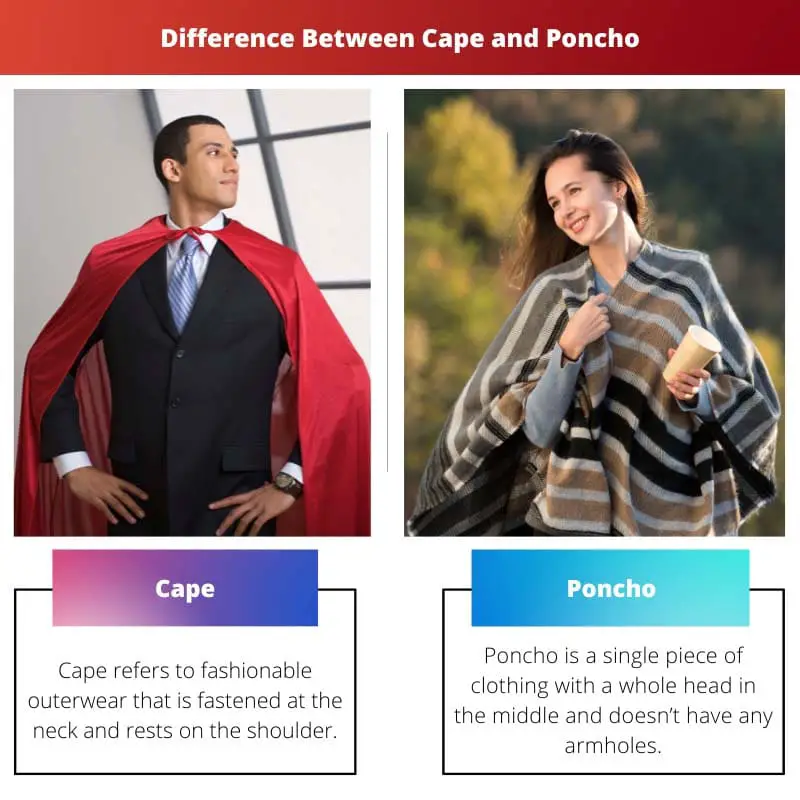If you are bored of wearing jackets and coats in winter and want to try alternatives then a shawl, cape, poncho are the good option for you.
This winter wear looks almost similar but has some distinguishable designs. Cape and poncho give a layer to your look and make a fashionable look and keep you warm at the same time.
Key Takeaways
- Capes are outerwear garments that drape over the shoulders and back, featuring a fastening at the front and sometimes a hood.
- Ponchos are loose, unstructured garments made from a single piece of fabric, with a hole for the head and no sleeves, providing easy-to-wear protection from the elements.
- Both capes and ponchos can be worn as fashionable or functional outerwear, offering warmth, style, and versatility in various settings.
Cape vs Poncho
Capes are more formal and associated with high fashion or historical clothing, while ponchos are more casual and associated with outdoor activities. Capes can also vary in length, from short capelets to full-length cloaks, while ponchos have a similar length all around.

Cape refers to fashionable outerwear that is fastened at the neck and rests on the shoulder. It cascades down the back to the mid-thigh or hips area.
Traditionally capes only cover the back of the body, but some capes have enough fabric to cover the front side, but they never meet in the middle. Only a string is used to tie the cape around the neck.
Poncho is a single piece of clothing with a whole head in the middle and doesn’t have any armholes. It is an outer garment that was developed for keeping the body warm.
The poncho has been used by the native Americans of the Patagonia and Andes (Current Peru, Bolivia, Chile, Argentina, and Ecuador) since the pre-Hispanic era.
Comparison Table
| Parameters of Comparison | Cape | Poncho |
|---|---|---|
| Origin | Medieval Europe. | Latin America. |
| Wearing style | Thrown over the shoulder. | Pull over the head. |
| Body cover | Cape covers only the back part of the body. | Poncho covers both the back and front parts of the body. |
| Length | Generally, longer compared to poncho. | Generally, shorter than a cape. |
| Opening | Front opening. | The front is closed. |
What is Cape?
Cape refers to sleeveless outerwear that is designed to be fastened around the neck and cascades down the back. Capes were widely used in Medieval Europe.
The cape has had the periodic return to fashion in 19th century Europe. Roman Catholic clergy wear the ferraiolo which was a type of cape. It is worn by them in any formal event which is outside the ritualistic context.
In fashion, the cape refers to shorter outerwear. The fashion cape doesn’t cover up the front part of the body. It is also used as rainwear which is a baggy and long protective garment that keeps you from the rain.
During the Victorian era, caped overcoats were very popular among men. At this time men wore caped Ulsters.
When it is worn as formal wear, it is known as an evening cape. Evening capes are made of lush materials, like velvet, silk, and satin.
Some fashionable capes are made of crochets or lacy knit patterns. This type of cape can be beaded or embroidered.
The cape has waned and waxed as a fashionable accessory as it has grown more complex. In Pop culture, it is associated with the superhero.
The linkage of the cape and superhero is quite unclear, but it has grown through the generations of comics and their huge fanbase.
In the modern era, the cape is also used by women for protecting their shoulders and neck. Many police forces now use a cape as a protector of their uniform, and these types of capes are made from waterproof material or plastic.

What is Poncho?
Poncho refers to a loose-fitted outer garment that has a hole in the middle for the head and doesn’t have any other hole and is made out of a single piece of fabric.
Poncho was originally made up of a hand-loomed, brightly colored, and rough fabric in the early cultures of Latin America.
Poncho is always made of a single piece of fabric which creates a diamond-like shape when worn. Poncho was developed for looking fashionable and keeping the body warm at the same time.
It has an extra piece of fabric that works as a hood. Rainproof ponchos are well-fitted with fasteners for closing the sides once they are draped over the body of the wearer.
The poncho was used as a typical cloth in South American cultures. In the 1850s it was first used regularly for US military forces who were serving Western plains.
These types of military ponchos were made of water-resistant fabric. During World War II, it was widely used in US military forces.
In modern times, the design of ponchos has changed a lot from the original ponchos. Modern ponchos are designed with different types of fabric materials, like crocheted or knitted, yarn or wool.
Modern ponchos are more than rainproof or warm cloth. Ponchos with festive colors or designs can be worn at festive events.

Main Differences Between Cape and Poncho
- Cape originated from Medieval Europe, on the other hand, the poncho is native to Latin America.
- Cape is a single piece of fabric thrown over the shoulder, on the contrary, the poncho is worn by a pull over the head.
- Cape covers the back part of the body, whereas poncho covers both front and back of the body.
- Cape is longer, reaches to the hip or upper thigh, than a poncho.
- The front part of the cape is always open and it is tied around the neck with a string, while ponchos have a hole for the head and the front remains close always.

References
- https://www.tandfonline.com/doi/abs/10.1080/17405904.2019.1656654
- https://www.sciencedirect.com/science/article/abs/pii/S0169814100000160
